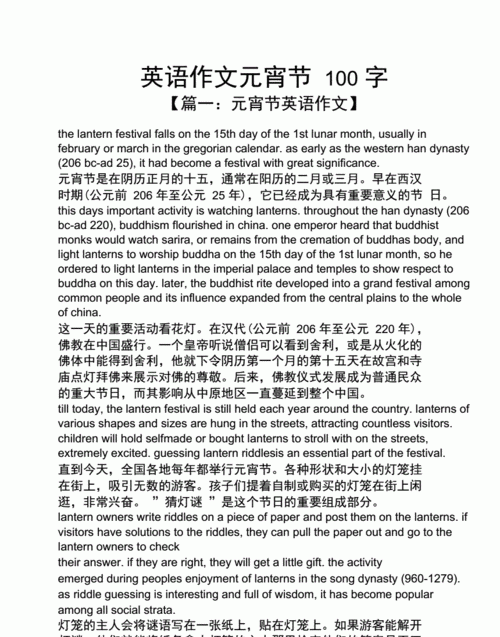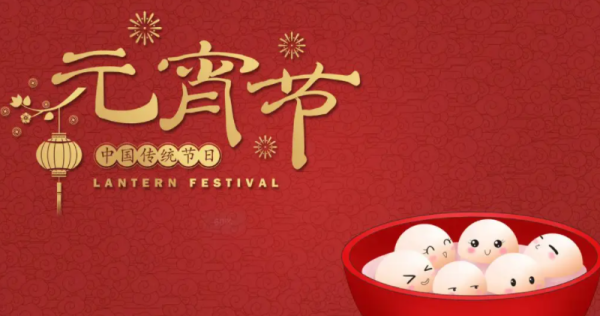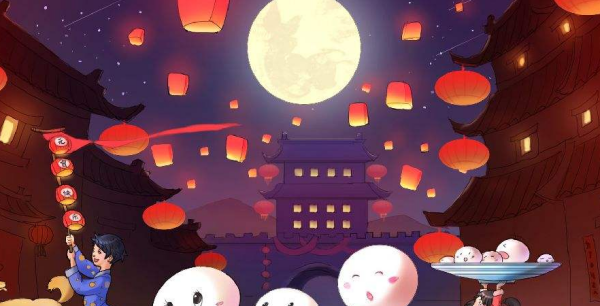本文目录
元宵节的由来与传说
元宵节的由来有两种
1是在汉文帝时,已下令将正月十五定为元宵节。汉武帝时,“太一神”的祭祀活动定在正月十五。(太一:主宰宇宙一切之神)。司马迁创建“太初历”时,就已将元宵节确定为重大节日。
还有一种说法是汉文帝登基以后文帝深感太平盛世来之不易,便把平息“诸吕之乱”的正月十五,定为与民同乐日,京城里家家张灯结彩,以示庆祝。从此,正月十五便成了一个普天同庆的民间节日――“闹元宵”。

元宵节的英语的日期是什么
The Lantern Festival is one of the traditional Chinese festivals, also known as Shangyuan Festival, Little First month, Yuanxi festival or Lantern Festival, which falls on the 15th day of the first lunar month. The formation of the Lantern Festival has a long process, rooted in the ancient custom of turning on lights to pray for good luck.
The Lantern Festival is mainly a series of traditional folk activities, such as watching lanterns, eating glutinous rice balls, guessing lantern riddles and setting off fireworks. In addition, the Lantern Festival in many places also added a dragon lantern parade, lion dance, walking on stilts, land boat rowing, yangko dance, beating drums and other traditional folk performances.
元宵节,中国的传统节日之一,又称上元节、小正月、元夕或灯节,时间为每年农历正月十五。元宵节的形成有一个较长的过程,根源于民间开灯祈福古俗。
元宵节主要有赏花灯、吃汤圆、猜灯谜、放烟花等一系列传统民俗活动。此外,不少地方元宵节还增加了游龙灯、舞狮子、踩高跷、划旱船、扭秧歌、打太平鼓等传统民俗表演。

元宵节习俗
1、耍龙灯
耍龙灯,也称舞龙灯或龙舞。见于文字记载的龙舞,是汉代张衡的《西京赋》,作者在百戏的铺叙中对龙舞作了生动的描绘。而据《隋书·音乐志》记载,隋炀帝时类似百戏中龙舞表演的《黄龙变》也非常精彩,龙舞流行于中国很多地方。华夏崇尚龙,把龙作为吉祥的象征。
2、踩高跷
踩高跷,是民间盛行的一种群众性技艺表演。高跷本属中国古代百戏之一种,早在春秋时已经出现。中国最早介绍高跷的是《列子·说符》篇:“宋有兰子者,以技干宋元。宋元召而使见其技。
元宵节的由来 英文手抄报150词
元宵节的由来英文介绍:
Lantem Festival The 15th day of the 1st lunar month.
The 15th day of the 1st lunar month is the Chinese Lantern Festival because the first lunar month is called yuan-month and in the ancient times people called night Xiao. The 15th day is the first night to see a full moon. So the day is also called Yuan Xiao Festival in China.
According to the Chinese tradition, at the very beginning of a new year, when there is a bright full moon hanging in the sky, there should be thousands of colorful lanterns hung out for people to appreciate. At this time, people will try to solve the puzzles on the lanterns and eat yuanxiao (glutinous rice ball) and get all their families united in the joyful atmosphere.

译文:
元宵节正月十五吃元宵的的习俗由来已久,元宵也叫汤圆”、“圆子”。据说元宵象征团圆,吃元宵意味新的一年合家幸福、万事如意。
元宵节闹花灯的习俗起源于道教的“三元说”;正月十五日为上元节,七月十五日为中元节,十月十五日为下元节。主管上、中、下三元的分别为天、地、人三官,天官喜乐,故上元节要燃灯。元宵节的节期与节俗活动,是随历史的发展而延长、扩展的。
就节期长短而言,到唐代已为三天,宋代则长达五天,明代更是自初八点灯,一直到正月十七的夜里才落灯,整整十天。与春节相接,白昼为市,热闹非凡,夜间燃灯,蔚为壮观。特别是那精巧、多彩的灯火,更使其成为春节期间娱乐活动的高潮。至清代,又增加了舞龙、舞狮跑旱船、踩高跷、扭秧歌等百戏内容,只是节期缩短为四到五天。
元宵节英语作文6句话
The first month is the first month of the lunar calendar. The ancients called "night" as "Xiao". The fifteenth day of the first month is the night of the first full moon of the year, so it is called "Lantern Festival".
正月是农历的元月,古人称“夜”为“宵”,正月十五是一年中第一个月圆之夜,所以称正月十五为“元宵节”。
The formation of the Lantern Festival has a long process, which is rooted in the ancient custom of turning on lights and praying.
元宵节的形成有一个较长的过程,根源于民间开灯祈福古俗。

According to general information and folklore, the fifteenth day of the first month has been paid attention to in the Western Han Dynasty, but the Lantern Festival on the fifteenth day of the first month was really regarded as a national folk festival after the Han and Wei dynasties.
据一般的资料与民俗传说,正月十五在西汉已经受到重视,不过正月十五元宵节真正作为全国民俗节日是在汉魏之后。
The rise of the custom of lighting lanterns on the 15th day of the first month is also related to the eastward spread of Buddhism. Buddhism flourished in the Tang Dynasty. Officials and people generally "light lanterns for Buddha" on the 15th day of the first month, and Buddhist lights spread all over the people. Since the Tang Dynasty, opening lanterns on the Lantern Festival has become a legal matter.
正月十五燃灯习俗的兴起也与佛教东传有关,唐朝时佛教大兴,仕官百姓普遍在正月十五这一天“燃灯供佛”,佛家灯火于是遍布民间,从唐代起,元宵张灯即成为法定之事。
The lantern festival mainly includes a series of traditional folk activities, such as appreciating lanterns, eating dumplings, guessing lantern riddles, setting off fireworks and so on.
元宵节主要有赏花灯、吃汤圆、猜灯谜、放烟花等一系列传统民俗活动。
以上就是关于元宵节英语传说50字 ,元宵节的由来与传说的全部内容,以及元宵节英语传说50字 的相关内容,希望能够帮到您。
